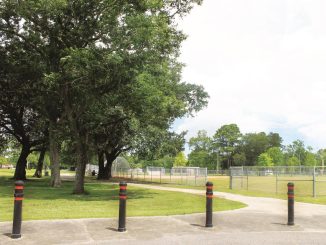
The LSU AgCenter’s 8th Annual Tomato Field Day in Waterproof, La., showed that the recent lack of rain can’t stop those who are determined to produce unusually large tomatoes.
LSU AgCenter county agent Dr. Bobby Fletcher has been promoting tomato production in Terrebonne Parish and surrounding area with this annual field day for the past seven years. He said even with the recent drought in the southern part of the state this year, producers were still able to show off their best produce at the event.
“This was not only a good year for some producers, despite the drought, but we also had a record crowd of 225 people participate,” Fletcher said at the June 8 event, adding, “Last year’s attendance was around 200.”
Fletcher and LSU AgCenter horticulture professor Dr. Jimmy Boudreaux conducted a field tour to show participants what various tomato diseases look like and to show off some of the more disease-resistant varieties. Both experts spend a great deal of time each spring and summer looking for the best varieties to plant in this part of the state.
For several years, some of the favorite parts of the field day have been contests involving the largest tomatoes and the best-tasting ones.
In this year’s competition for the largest tomato, the winner was a 20-ounce giant grown by Hugh Paul Fanguy from the Bayou Blue area near Houma.
Fanguy, a retired agronomist with the U.S. Department of Agriculture’s sugarcane lab in Houma, said he grows tomatoes for his own use and for sale.
“I actually raise 12 different varieties of tomatoes, and I have a vegetable stand out on my land where I sell some to the public,” Fanguy said.
Fanguy said he works very closely with Fletcher and follows LSU AgCenter recommendations, such as using the black plastic on the rows for weed control and using trickle irrigation.
“According to the records, this is as dry as it’s been since 1916, so the irrigation was a must this year,” Fanguy said.
The tomato tasting contest also draws loyal participants during the field day activities. This year the three winners, from first to third place, were Celebrity, BHN 444 and Jet Star.
Fletcher said in addition to the drought being a problem for producers, several diseases also caused problems.
“As always, the wilts can cause some major problems,” Fletcher said, adding, “Fusarium wilt is the most common and destructive soil-borne disease in the area. This disease is most severe during warm weather when it can enter the plant through the roots to develop inside the stem.”
He explained that the plants with this disease will show a progressive yellowing and wilting starting at the bottom. A week or two may elapse between the first symptoms and the plant’s death.
In addition to that disease, Fletcher said some producers in the area also were having problems with southern blight and tomato spotted wilt virus.
“Tomato spotted wilt virus has really been a major problem this year as the thrip populations have been very high, sometimes causing 100 percent losses,” he said, explaining thrips spread the disease to tomato plants.
Although some of these diseases can be treated, Fletcher said it’s often best to remove diseased plants to attempt to prevent spreading diseases to plants that weren’t yet affected.




Be the first to comment